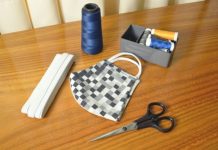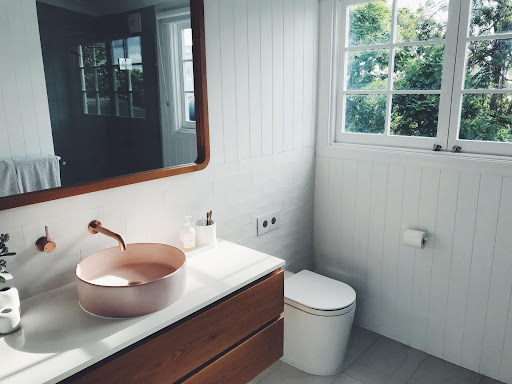Scientific research on human life, media coverage, and our own daily observations show that our society is ageing inevitably. The passing years affect not only us but also the space in which we live. Therefore, the bathroom for the seniors should be different from the usual one and fully correspond to their capabilities.
The bathroom is one of the most demanding in home furnishing, especially if it is intended for use by elderly people. In this case, the important question is how to equip a bathroom, creating full functionality and maximum safety? The following information will draw your attention to the most important points in organising a bath for the seniors.
Freedom of movement and freedom of use
A bathroom for seniors or people with disabilities must be free of any interior barriers. That is, the maximum possible freedom of movement should be organised. Mandatory barriers include all doors of various designs. Optional – sills, floor level drops, floor connecting strips, decorative ledges. In a word, this is everything that hinders or restricts free movement.
Another type of restriction relates to the convenience and freedom of use of basic bathroom fixtures. The limitations lie in their inability to adapt to the needs of the elderly and disabled, that is, there is no freedom to use the devices. For example, these are a toilet with an underestimated level of placement; a high or low mounted shell; a small tap with a short spout or a tap with a tight swivel mechanism; possibly too large or deep tub with high sides.
Even in the smallest room, maximum mobility is important.
It is necessary to resolve the issue starting from the entrance. If there is a constructive possibility, the doorway should be expanded as much as possible. The minimum width of the doorway, which should not be limited by the door leaf, is 90 cm.
For comfortable access for wheelchair users, the size of the minimum space is 150 cm in diameter.
Should you choose a bathtub or a shower?
What is the best to install, what kind of body wash equipment? Without a shadow of doubt or hesitation, of course, this is a shower. And there are several good reasons for this statement.
Benefits of a shower and which shower is better
In addition to the fact that a shower is preferable to a bath, it should be noted that the best option for arranging a walk-in shower. This is a shower without a tray, with a drain on the floor. This allows you to get rid of the problem of inconvenient stepping over the edge of the shower stall tray, due to the level of the tray not matching the floor level. Many, when choosing such an organization of wastewater discharge, are concerned about the possibility of water flowing through the floor insulation. You will just need to properly lay the tiles in the bathroom when arranging a shower in order to exclude possible troubles, and your doubts will be dispelled.
The absence of walls and a sill in the shower minimizes the likelihood of losing balance and falling. Such a constructive solution gives additional space to the room and provides a great opportunity for free movement.
Such an organization of the shower allows you to remove certain restrictions, for example, in cases when the help of another person is required while bathing.
Bathtub for seniors
A bath, unlike a shower, is less adapted to the needs of the elderly. When using a bathtub, additional problems arise that are directly related to its design features. They are especially noticeable when entering or leaving it. For persons with a low level of physical capabilities, it is sometimes difficult to get out of even shallow baths.
If in the process of renovation or new construction, you have opted for a bath, and not a shower, pay attention to special models for the elderly and people with disabilities. The presence of a door and a large built-in seat is a fundamental difference between a sit-down bathtub with a door for the elderly and the design of traditional products.
In addition, do not forget to call the best Canberra plumbers when installing the device. It is very important that everything is safe and well done so that later you would not have additional problems and difficulties.
In the event that you do not plan to replace the traditional design with a modern one or, for objective reasons, do not have the opportunity to do this, you need to pay attention to the equipment for the bathtub with separate functional elements. These include specially designed benches, chairs, seats, handrails, holders, ladders and stands.
Handrails
Bathroom attachments s that facilitate daily routines, such as handrails and handles, are some of the most important pieces of accessories. Installing them in the right places on the wall helps to enter the bathtub, get out of it, go in and out of the shower stall, or sit down, get out of the toilet.
Bathroom chair
The shower without walls and tray can be additionally equipped with a plastic chair or stool. It can be a fixed or foldable version of the highchair. These special stools and chairs do not take up much space, and you can use them when needed.
Floor covering
For new construction or renovation with the replacement of floor tiles, you should choose tiles with a non-slip surface of at least R9 class. The variety of floor tiles offered by manufacturers will allow you to make such a choice in such a way that the flooring is both beautiful and functional.
A good solution is to use anti-slip floor mats, especially in the shower or bath area. But remember that all kinds of additional limited coverings, even such as rugs, can be an obstacle for people using a wheelchair, crutches, or walker.
Conclusion
According to statistics, 47% of injuries involving people over the age of 60 occur at home. In the first place among the places of injury at home is the bathroom. This is why it is so important to ensure the safety and comfort of the elderly in it. Make sure to thoroughly think about the convenience and design of this room before starting the renovation.





























